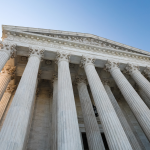Just in time for Independence Day, the U.S. Supreme Court this morning reminded Americans of the significance of the nation’s most basic principle: that all men are created equal. In Students for Fair Admissions v. Harvard, the justices declared that the race-based admissions policies at Harvard University and the University of North Carolina are unconstitutional. Each student, the court said, “must be treated based on his or her experiences as an individual—not on the basis of race. Many universities have for too long done just the opposite. … Our constitutional history does not tolerate that.” The ruling is a vindication of the principle that people should be rewarded or punished for their own actions, not for those of their ancestors—and it brings us closer to the day when the Declaration of Independence’s principles are made a reality.
There was never any real dispute that Harvard and UNC discriminated based on race when choosing which students to admit. The only question was whether that discrimination—which the colleges claimed was done for “benign” reasons—was tolerable under the legal rules that forbid either public universities like UNC, or private universities that receive government funding, such as Harvard, to discriminate based on race. It might seem obvious that the answer is no, but legal precedents such as University of California v. Bakke (1978) have given rise to the theory that colleges can discriminate based on race if they’re doing so in order to increase “diversity”—that is, if they’re attempting to balance the racial population in the school in order, or so it is said, to improve the educational experience.
That idea has long been regarded as suspicious, in part because only one justice in the Bakke case even bought the theory to begin with. But since the 1970s, universities devoted to racial balancing have seized upon it, even creating entire offices at their schools devoted to this “diversity.” Then in the Grutter case in 2003, the court gave that “diversity” rationale a boost. The court held that judges would defer to the choices of university administrators as to whether counting race as a criterion for admission was the best way to “diversify” the student body—and it set a 25-year deadline for the end of race-based admissions. Limited as that seemed to be, advocates of race preferences saw Grutter as permission to engage in racial balancing across the board.
The problem, of course, is that discriminating in favor of someone based on race necessarily means discriminating against another person based on race, at least when you’re talking about the chance of being one of the tiny number (about 4,000) of students admitted to a place like Harvard. As today’s ruling makes clear, Harvard’s discrimination was quite unjustifiable. Under the school’s admissions policies, for example, black students whose test scores fell in the fourth decile were more likely to be admitted than Asian students in the first decile. In fact, Harvard officials worked quite hard to discriminate against Asian students, often concealing its discriminatory policies under the disguise of vague “personality” tests. Nor are such racial preferences a real benefit even to their recipients. Evidence shows that students “benignly” admitted to colleges their backgrounds haven’t prepared them for are more likely to drop out—and they will never be able to avoid the stigma of being an “affirmative action case.”
Today’s decision reiterates that racial discrimination violates our constitutional commitment to the equal protection of the laws. The notion adopted in Bakke and Grutter that schools can discriminate to achieve diversity, writes Chief Justice John Roberts, raises “serious problems of justice”—and for that reason, the Grutter case included a number of limits on acceptable “diversity” programs. First: no quotas. Second, no insulating some ethnic groups from competition against others ethnic groups. Third: there must be some point at which racial preferences in admissions will come to an end. “The importance of an end point was not just a matter of repetition,” writes Roberts. “It was the reason the Court was willing to dispense temporarily with the Constitution’s unambiguous guarantee of equal protection.”
The Grutter case’s limit, in fact, was an odd and arbitrary 25-year rule: after 25 years, the court said, such policies should come to an end. That was bizarre—and Justice Clarence Thomas attacked it slyly in his own opinion in Grutter. “I agree with the Court’s holding that racial discrimination in higher education admissions will be illegal in 25 years,” he wrote. “I respectfully dissent from the remainder of the Court’s opinion and the judgment, however, because I believe that the Law School’s current use of race violates the Equal Protection Clause and that the Constitution means the same thing today as it will in 300 months.”
Now, only 20 years later, the court puts teeth into the Grutter time limit. One fatal flaw in the Harvard and UNC programs is that “no end is in sight,” writes Justice Roberts—meaning they will, in principle, go on forever. Unlike other kinds of admissions programs, which establish standards by which progress can be measured, “the question whether a particular mix of minority students produces ‘engaged and productive citizens,’ sufficiently ‘enhance[s] appreciation, respect, and empathy,’ or effectively ‘train[s] future leaders’ is standardless.” And without having any clear limit, the Harvard policy lacks what Grutter said was critical: some point at which discrimination will cease.
What’s more, the Harvard and UNC admissions programs relied so heavily on race that they “tolerate the very thing that Grutter foreswore: stereotyping. The point of [the] admissions programs is that there is an inherent benefit in race qua race—in race for race’s sake. [The colleges] admit as much.” But the whole point of a society of equal laws is that people are judged on their own individual merits, not based on their biological ancestry.
Strong as the majority opinion is, however, it’s nothing like the fireworks in Justice Thomas’s concurrence. In an intense 58-page concurrence riddled with references to the historical experience of slavery, the Civil War, and the Jim Crow south in which Thomas himself grew up, Thomas throws takes no prisoners in denouncing race-based discrimination by the government—including that which is supposedly beneficial. “This vision of meeting social racism with government-imposed racism,” he writes, is “self-defeating, resulting in a never-ending cycle of victimization.” Advocates of racial preferences, he observes, have never offered an answer to the question of “how [to] explain the need for race-based preferences to the Chinese student who has worked hard his whole life, only to be denied college admission in part because of his skin color? If such a burden would seem difficult to impose on a bright-eyed young person, that’s because it should be. History has taught us to abhor theories that call for elites to pick racial winners and losers in the name of sociological experimentation.”
Thomas—whose own biography is a testament to rising above life’s challenges—concludes with a rousing statement of principle: “Individuals are the sum of their unique experiences, challenges, and accomplishments. What matters is not the barriers they face, but how they choose to confront them. And their race is not to blame for everything—good or bad—that happens in their lives. A contrary, myopic world view based on individuals’ skin color to the total exclusion of their personal choices is nothing short of racial determinism.” Raced-based policies “fly in the face of our colorblind Constitution and our Nation’s equality ideal,” Thomas concludes. “While I am painfully aware of the social and economic ravages which have befallen my race and all who suffer discrimination, I hold out enduring hope that this country will live up to its principles so clearly enunciated in the Declaration of Independence and the Constitution of the United States: that all men are created equal, are equal citizens, and must be treated equally before the law.”
But what will today’s decision actually lead to? Unfortunately, it seems likely that no matter how clearly the Supreme Court sends the message that racial discrimination is illegitimate, the academic world is so wedded to them that it will find ways to evade or break the law rather than let go of such policies. That’s been the experience in California, for example, where more than 30 years ago the state passed a Civil Rights Initiative prohibiting universities from engaging in such race-based admissions policies. Since then, the state attorney general has consistently refused to enforce that law, and university officials have simply found ways to disguise their racial prejudices—by, for example, using “personal narratives” on application forms as a substitute for explicit quotas.
Will a similar outcome follow from today’s decision? That will be one topic that I’ll discuss with George Mason law professor David E. Bernstein, author of Classified: The Untold Story of Racial Classification in America, at a Goldwater Institute webinar on July 11 at 1:00 p.m. Arizona time. It’s free to join us—but registration is required.
Timothy Sandefur is the Vice President for Legal Affairs at the Goldwater Institute.









